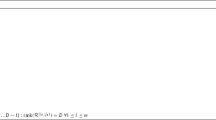Abstract
The algebraic immunity of a Boolean function is a parameter that characterizes the possibility to bound this function from above or below by a nonconstant Boolean function of a low algebraic degree. We obtain lower bounds on the algebraic immunity for a class of functions expressed through the inversion operation in the field GF(2n), as well as for larger classes of functions defined by their trace forms. In particular, for n ≥ 5, the algebraic immunity of the function Tr n (x −1) has a lower bound ⌊2√n + 4⌋ − 4, which is close enough to the previously obtained upper bound ⌊√n⌋ + ⌈n/⌊√n⌋⌉ − 2. We obtain a polynomial algorithm which, give a trace form of a Boolean function f, computes generating sets of functions of degree ≤ d for the following pair of spaces. Each function of the first (linear) space bounds f from below, and each function of the second (affine) space bounds f from above. Moreover, at the output of the algorithm, each function of a generating set is represented both as its trace form and as a polynomial of Boolean variables.
Similar content being viewed by others

References
Meier, W., Pasalic, E., and Carlet, C., Algebraic Attacks and Decomposition of Boolean Functions, Advances in CryptologyEUROCRYPT 2004. Proc. Int. Conf. on the Theory and Applications of Cryptographic Techniques, Interlaken, Switzerland, Cachin, C. and Camenisch, J., Eds., Lect. Notes Comp. Sci., vol. 3027, Berlin: Springer, 2004, pp. 474–491.
Bayev, V.V., On Some Algorithms for Constructing Low-Degree Annihilators for Boolean Functions, Diskret. Mat., 2006, vol. 18, no. 3, pp. 138–151 [Discrete Math. Appl. (Engl. Transl.), 2006, vol. 16, no. 5, pp. 439–452].
Bayev, V.V., On the Complexity of Finding Low-Degree Annihilators for Boolean Functions, Proc. Int. Scientific Conf. on Security and Counter-Terrorism Problems, Moscow State Univ., 2005, Moscow: MCCME, 2006, pp. 198–204.
Braeken, A. and Preneel, B., On the Algebraic Immunity of Symmetric Boolean Functions, Progress in CryptologyINDOCRYPT 2005. Proc. 6th Int. Conf. on Cryptology in India, Bangalore, India, Maitra, S., Veni Madhavan, C.E., and Venkatesan, R., Eds., Lect. Notes Comp. Sci., vol. 3797, Berlin: Springer, 2005, pp. 35–48.
Dalai, D.K., Gupta, K.C., and Maitra, S., Cryptographically Significant Boolean Functions: Construction and Analysis in Terms of Algebraic Immunity, Proc. 12th Int. Workshop on Fast Software Encryption (FSE 2005), Paris, France, Gilbert, H. and Handschuh, H., Eds., Lect. Notes Comp. Sci., vol. 3557, Berlin: Springer, 2005, pp. 98–111.
Dalai, D.K., Maitra, S., and Sarkar, S., Basic Theory in Construction of Boolean Functions with Maximum Possible Annihilator Immunity, Des. Codes Cryptogr., 2006, vol. 40, no. 1, pp. 41–58.
Dalai, D.K. and Maitra, S., Balanced Boolean Functions with (More than) Maximum Algebraic Immunity, Proc. Int. Workshop on Coding and Cryptography (WCC 2007), Versailles, France, 2007, Augot, D., Sendrier, N., and Tillich, J.-P., Eds., pp. 99–106.
Carlet, C., A Method of Construction of Balanced Functions with Optimum Algebraic Immunity, Cryptology ePrint Archive, 2006, Report 2006/149. Available at http://eprint.iacr.org/2006/149.
Armknecht, F. and Krause, M., Constructing Single-and Multi-output Boolean Functions with Maximal Algebraic Immunity, Proc. 33rd Int. Colloq. on Automata, Languages, and Programming (ICALP 2006), Venice, Italy, Bugliesi, M., Preneel, B., Sassone, V., and Wegener, I., Eds., Lect. Notes Comp. Sci., vol. 4052, Berlin: Springer, 2006, Part II, pp. 180–191.
Qu, L., Feng, G., and Li, C., On the Boolean Functions with Maximum Possible Algebraic Immunity: Construction and a Lower Bound of the Count, Cryptology ePrint Archive, 2005, Report 2005/449. Available at http://eprint.iacr.org/2005/449.
Li, N. and Qi, W.-F., Construction and Analysis of Boolean Functions of 2t+1 Variables with Maximum Algebraic Immunity, Advances in CryptologyASIACRYPT 2006. Proc. 12th Int. Conf. on the Theory and Application of Cryptology and Information Security, Shanghai, China, Lai, X. and Chen, K., Eds., Lect. Notes Comp. Sci., vol. 4284, Berlin: Springer, 2006, pp. 84–98.
Botev, A.A., On Properties of Correlation-Immune Functions with High Nonlinearity, Cand. Sci. (Phys.-Math.) Dissertation, Moscow: Moscow State Univ., 2005.
Tarannikov, Yu.V., On Correlation-Immune and Stable Boolean Functions, Mat. Vopr. Kibern., vol. 11, Moscow: Fizmatlit, 2002, pp. 91–148.
Nawaz, Y., Gong, G., and Gupta, K.C., Upper Bounds on Algebraic Immunity of Boolean Power Functions, Proc. 13th Int. Workshop on Fast Software Encryption (FSE 2006), Graz, Austria, Robshaw, M.J.B., Ed., Lect. Notes Comp. Sci., vol. 4047, Berlin: Springer, 2006, pp. 375–389.
Author information
Authors and Affiliations
Corresponding author
Additional information
Original Russian Text © V.V. Bayev, 2008, published in Problemy Peredachi Informatsii, 2008, Vol. 44, No. 3, pp. 81–104.
Supported in part by the Russian Foundation for Basic Research, project no. 07-01-00154.
Rights and permissions
About this article
Cite this article
Bayev, V.V. Some lower bounds on the algebraic immunity of functions given by their trace forms. Probl Inf Transm 44, 243–265 (2008). https://doi.org/10.1134/S0032946008030071
Received:
Accepted:
Published:
Issue Date:
DOI: https://doi.org/10.1134/S0032946008030071



